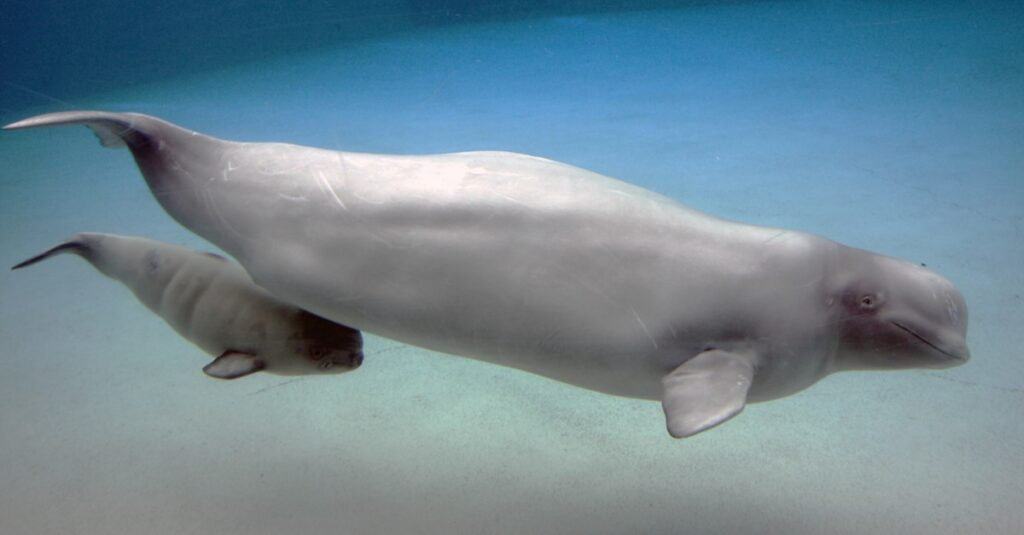The beluga whale (Delphinapterus leucas) is a unique marine mammal that lives in Arctic waters. The species has earned a few common nicknames that relate to their special characteristics:
- Sea Canary: Belugas are known for their constant vocalization, often letting out bird-like calls for hunting, mating, and other communication.
- Melonhead: Echolocation plays a big role in beluga behavior. This is made possible by a specialty organ in the front of their heads called the melon.
- White Whale: The beluga is the only whale that features a naturally all-white appearance. This provides them with camouflage against predators around the bright white sea ice.
Belugas are social creatures and live in pods between 2 and 20 individuals, with an average size of 10. They belong to the infraorder Cetacea, home to similar animals like dolphins, porpoises, and sperm whales. Their closest evolutionary relative is the narwhal—the two species are the sole members of the Monodontidae family.
The beluga whale features a few glaring differences from all of these related Cetacea: shedding skin and the absence of a dorsal fin. Each year, their outer skin layer will thicken and turn yellow, before being rubbed off by the belugas against the ocean floor. They are also one of the few Cetaceans that lack a dorsal fin, allowing them to glide under ice and access air holes with ease.
The Beluga Whale Diet

Beluga whales consume a wide variety of foods.
©kuremo/Shutterstock.com
Beluga whales eat a diverse diet that includes crabs, shrimp, squid, clams, and octopus. They also consume a large amount of fish, including cod, herring, flatfish, salmon, and eulachon. The average beluga eats between 2.5 and 3% of its body weight in food each day—anywhere from 40 to 100 pounds depending on the size of the whale.
Beluga whales migrate frequently and live in populations all around the Northern Hemisphere, so their diet changes with their location and the passing seasons. Many individuals travel thousands of miles every year!
For instance, when swimming through the Beaufort Sea, their primary source of food is Arctic cod. Populations near Greenland have a wider selection of prey: northern shrimp, Greenland halibut, and rose fish. When moving through deeper water, belugas will feed on invertebrates like sandworms, shrimp, sea snails, octopus, and bristle worms.
How Do Beluga Whales Hunt?

Mother and baby Beluga whale swimming together. Toothed whales use echolocation to navigate in murky water with low visibility.
©CampCrazy Photography/Shutterstock.com
Belugas have a wide range of motion in their neck, allowing them to feed along the sea floor with ease. Some evidence suggests that they are able to produce a strong enough suction with their mouths to gather prey indirectly. When foraging along the ocean floor, beluga whales will explore at depths of 20 to 40 meters. However, they have been known to dive over 500 meters in search of food.
Beluga whales eat more food in the winter, as evidence shows that their blubber is thickest in early spring. They are thought to forgo hunting throughout their summer migration, as their blubber becomes thin by early fall.
When hunting as a group, beluga whales will gang up on a school of fish, pushing them into shallow water before dining on their prey. Belugas do not have the need or ability to chew their food—everything is eaten whole!
The species has a prominent echolocation organ on the front of their head, called the melon. In addition to its use for communication, beluga whales use the melon to hunt in dark waters. Some researchers question whether beluga calls can be considered a “language,” as consistent vowel sounds have been noted. They are susceptible to noise pollution caused by humans, which changes the frequency of their calls.
Do Beluga Whales Have Predators?

Beluga whale mother with a young calf.
©Christopher Meder/Shutterstock.com
Beluga whales have a few natural predators, including polar bears and killer whales. Unfortunately, belugas have also been a human hunting target for centuries. This has been outlawed in most parts of the world, but poaching is still a serious problem.
As winter falls on the arctic, many parts of the sea quickly come to a freeze. When belugas move for warmer waters, they often get stuck under sheets of ice, unable to find their way to air. Polar bears are not only able to smell these trapped belugas, but they can even pull the bodies—often weighing over 2,000 pounds!—onto the ice for dinner.
Killer whales live in the same arctic waters as belugas. Groups of killer whales can take down both young and adult belugas—this has been documented frequently in the waters of Alaska, Canada, and Russia. Belugas do have one advantage in this situation: their lack of a dorsal fin. Killer whales have a dorsal fin that can reach over 6 feet in length, preventing them from getting too close to the surface ice or breathing holes.
The photo featured at the top of this post is © Christopher Meder/Shutterstock.com
FAQs (Frequently Asked Questions)
How Big Are Beluga Whales?
Beluga whales can grow to weigh over 4,000 pounds. The species is sexually dimorphic, as the male whales tend to be 25% larger than the females. The average male weighs between 2,500 and 3,500 pounds and grows to a length between 11 and 18 feet. Females may weigh anywhere from 1,500 to 2,500 pounds and reach lengths between 10 and 13 feet. Belugas reach their maximum size and sexual maturity around 10 years of age.
What is the Lifespan of Beluga Whales?
Beluga whales have an average lifespan between 30 and 35 years. Recent studies suggest that some individuals may live upwards of 70 to 80 years. Radiocarbon dating of deposits in the teeth allows researchers to estimate the age of belugas.
Are Beluga Whales Dangerous?
Beluga whales are massive animals that can be extremely dangerous if approached. Humans should never come into direct contact with belugas—even feeding wild whales can be an issue, as they may become dependent on humans for food. They are often seen with their mouths open, which is a sign of aggression.
Thank you for reading! Have some feedback for us? Contact the AZ Animals editorial team.







